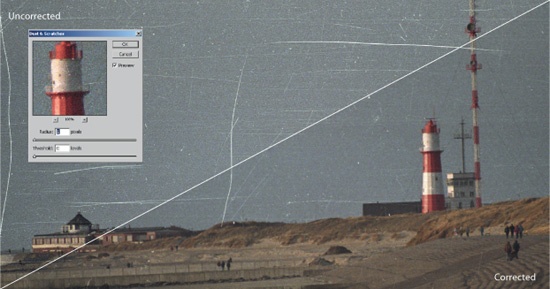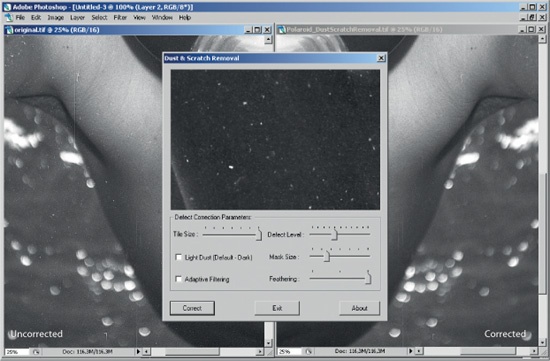Adobe Photoshop is the gold standard for professional image processing. The program has useful tools not only for creative image manipulation, but also for correcting typical flaws in scanned images. It allows you to straighten tilted horizons, perform perspective corrections, and remove red-eyes. There are a number of tools in Photoshop for scratch removal in black and white film: apart from SilverFast, no other scanner program has suitable tools for that. Plug-ins make Photoshop particularly useful for sophisticated special jobs, such as grain removal or color restoration of faded originals.
Contents
| Dust and Scratch Removal |
| Image Corrections |
| Photoshop Plug-ins from Applied Science Fiction |
| Removing Color Casts |
| Match Color |
| Noise Reduction with Noise Ninja |
| Noise Reduction with Neat Image |
Under Filter ▸ Noise Photoshop offers Dust and Scratches. It affects the entire image, unless it is used with a selection or a mask. The only parameters available for the filters are Threshold and Radius. The preview shows how the weakest setting reduces the image sharpness. The effects of scratch removal are acceptable if the correction is limited to a radius of 1. Larger radii lead to unacceptable loss of quality. The filter is acceptable for fine scratches but is not suitable for deep scratches. From my own experience, for quality reasons, I can hardly recommend this method. The Clone Stamp or the Polaroid plug-in is better.
A commonly used retouching tool in Photoshop is the Clone Stamp. To use this tool, first pick a suitable source region and copy the pixel pattern from that region to patch up the damaged areas. The size of the stamp is adjustable – it is possible to perform corrections down to a single pixel. In scanned images, scratches rarely occur in isolation; usually, many small scratches must be dealt with. Add to this the usual fine dust and fibers that are picked up by film, and you see there can be serious need for corrections, even with carefully handled film.
If you are a quality fanatic, you can remove all such defects using the Clone Stamp with excellent results. However, it is enormously time-consuming to do that. Because the Clone Stamp transfers 1:1, you must take great care in selecting your source area; otherwise, you will impair the texture and color of the target area. The Photoshop Healing Brush is more flexible; but, when used properly, the Clone Stamp is hard to beat for quality. Even ICE costs you some sharpness, which is not the case with Clone Stamp. Cloning is much too cumbersome for regular dust and scratch removal after the scan. It is not practical for high-volume scanning.
Besides the Clone Stamp, you can also use the Healing Brush for correcting dusty and scratched image regions. You still have to pick the source region yourself, but Photoshop calculates automatically what to use to fill the spot. Occasionally, you will get some unwanted results from the brush, such as having a color from a neighboring area pulled into the correction by mistake. In such cases, you can go back to the Clone Stamp. With the ![]() key pressed, you first click on the area you want to use as the source for the corrections. Based on these data, Photoshop will calculate the correction. Then you can brush over the defective areas. The smaller the brush radius, the more precise the correction; but also, the more time-consuming the job for the whole image.
key pressed, you first click on the area you want to use as the source for the corrections. Based on these data, Photoshop will calculate the correction. Then you can brush over the defective areas. The smaller the brush radius, the more precise the correction; but also, the more time-consuming the job for the whole image.
If this method were used to remove every single speck of dust – and the harsh LED lighting of the Nikon scanners captures a lot of them – retouching with the Healing Brush would be very laborious. However, fixing a small number of image defects with the Healing Brush is typically quick and easy.
Since Photoshop CS2: Spot Healing Brush
Both Healing Brush and Clone Stamp always require manual input of the source area. This time-consuming step is no longer needed with the new Spot Healing Brush: You simply activate the tool and immediately start to work. Spot Healing Brush is therefore an ideal retouching tool for big dust and scratch removal jobs.
You can download a free plug-in for dust and scratch removal from Polaroid at www.polaroid.com/service/software/poladsr/poladsr.html. The plug-in is installed under Filter ▸ Polaroid ▸ Dust & Scratch Removal. Because it lacks before-after comparison and a preview for the entire image, it is not very user-friendly. However, you can get used to it; and it is, after all, a freeware tool. The job it does on dust removal for black and white films is also excellent. Even with only minimal configuration, the dust across the entire image will be eliminated. There is no need to mark the affected areas. The plug-in automatically detects areas of dust. With a weak setting, you can apply the filter to the whole image by activating the switch Light Dust. The scratch removal is not as powerful, but most software-based tools have a problem with scratch removal anyway.
Unfortunately, the position of the preview window of the Polaroid plug-in cannot be chosen freely. However, there is a little trick that can help matters. Simply select a particularly dusty area with the Rectangular Marquee – the selected part of the image will be displayed in the little preview window. If the selection is too large, the preview will only show the upper left corner of the area. When making a selection, note that the filter works for the selected area only.
This is especially useful when you try to get the hang of this plug-in, since you can see the difference between the corrected and uncorrected portions of the image. For dusty black and white film, this tool is a great help; it is much faster than the cloning method. But, for long scratches, some work will still need to be done with the Clone Stamp.




